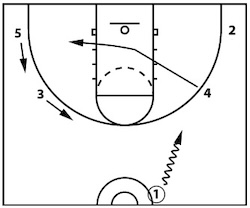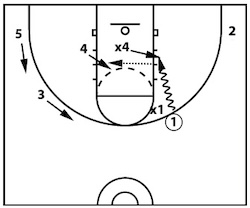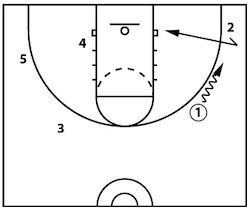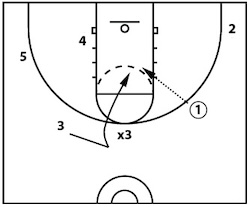Youth Offense For 8-11 Year Olds - This "Dribble Adjustment" Led To Big Offensive Improvements
Last year, I made a small change that got big results within my youth offense. And it could help you.
In this article, we're going to cover:
- Universal Offensive Concepts - What They Are & Why They Are Vital Development
- How I Taught Youth Offense In the Past
- Background On Last Year's Season
- Why My Players Had Difficulty Running Offense
- A Simple Tweak That Led Offensive Success
- Why This Counterintuitive Approach Led To More Scoring
- Why This Offensive Change Still Benefited Long Term Development
- The Offense I Modeled This Change After
Alright, let's get into it!
Longtime subscribers know that I've been a huge proponent of teaching universal offensive concepts to youth basketball players. This often coincides with teaching a version of motion offense.
If you're not familiar with the term universal offensive concepts (UOCs), they are things like getting open using cuts, utilizing screens, creating and maintaining good spacing, and moving off dribble penetration.
UOCs are offensive skills that apply to any offense or set play.
It doesn't matter what the coach teaches at the higher levels, you have developed skills that will make you a better player in their system.
For a detailed explanation, you can read this article Youth Coaches: Destroy Your Playbook and Do This Instead.
When teaching offense to youth teams in the past, here are the universal offensive concepts I started with...
- 5-Out Offense (With the option of cutting to the block to post temporarily)
- Spacing (Create space from teammates so the defense has to cover more ground)
- How to get open - L-cut, V-cut, backdoor cut
- Pass and move - Cut to the basket, cut to space, or screen
First, a little background...
Last year, I coached my children's 2nd/3rd grade and 4th/5th grade recreational teams.
We have about 10 practices for the season. Each practice is one hour each.
We also only get one basket for practice.
There are 7 games throughout the season.
To simplify, I taught a 5-out pass and cut.
Let's just put it this way... it was very difficult for these age groups to run the offense.
- When spaced properly, a lot of 2nd to 5th graders aren't strong enough to make the pass to their teammate.
- Many can't recognize the situation fast enough to pass the ball to the cutter.
- The ball handler would often freeze at the top of the key trying to run the offense. They weren't attacking.
Almost all of our success was in scramble and transition situations... after steals, defensive rebounds, dribble penetration, etc.
I think a lot of that had to do with the fact that we only had 3 practices before our first game and 10 practices for the entire season.
So a couple of games into the season, I had enough of them just freezing on offense.
When the ball handler brought the ball up the court, I instructed them to, "Attack the rim. Get a layup."
Then as soon as he got past half court, I would instruct the player on the right wing to basket cut and fill opposite.
I chose the right wing because all of our players were right-handed, and that's where they drifted.
By far, this generated the most offensive success for us!

Why This Counter-Intuitive Approach Worked... And It Actually Made Things Easier To Dribble Penetrate
Now, this might sound counterintuitive... how is having a player cut in the lane going to clear up more space. Won't they clog up the lane?
Before I answer, I just want to preface that I have A LOT of experience with this offense. 20+ years of playing and coaching within it.
When I played high school basketball, a lot of teams played zone defense against us. We excelled at attacking the rim and creating drive-and-kick 3s within the offense.
I even saw the 1998 Cedar Rapids Prairie basketball team win a state championship with the offense.
You're still able to generate a lot of scoring opportunities because...
- There is more space on the perimeter when that player initially cuts through.
- Even if the cutter hasn't started to clear the lane yet, the help defender is often focused and preoccupied with the cutter.
And when you combine that with the help defender's momentum taking them away from the ball, it adds another layer of difficulty.
They not only have to recognize it quickly enough, which is difficult, they have to change direction and their momentum to stop the ball.
And with youth players, the help defender almost always follows the cutter to the opposite corner. Even high school players have difficulty with this.
- If the defender does help in time, you teach your cutter to slide to an open position around the basket for a pass.
If the ball handler still shoots, the cutter is now in prime position for an offensive rebound.
- This attack mentality gets a lot of fouls called on the defense and you get more points via free throws. I emphasize for them to take their momentum to the basket rather than drifting or fading away.

Even though our cutter was often in good position for offensive rebounding, I told our players on the opposite side of the ball to crash the boards when a shot went up.
If you've coached youth basketball before, you probably know, the best offensive rebounding team usually has a lot of success since there are so many missed shots in youth basketball.
So what do you do if the ball handler can't get to the rim? What if they get stopped?
In practice, we still held onto our core offensive principles. We taught our players principles of getting open on offense, such as:
- Take your defender a couple of steps down toward the paint
- Change pace
- Explode out of the cut to the open perimeter spot
This still provided players with the foundation for the next steps which included....
- Cut to space. So off dribble penetration, our players would locate to an open spot. We emphasized cutting away from the ball handler.
If you happen to cut into the ball handler or another player, no big deal. Just cut to an open spot.
- If your defender plays above the 3-point line, set them up and cut backdoor.
- If the ball handler dribbles at you, cut backdoor.
At times the ball handler would veer towards the corner. This created tons of backdoor opportunities for the player in the corner.


Was it still chaos at times? Absolutely!
Were there still turnovers? Yes. But fewer because we were making aggressive mistakes rather than tentative mistakes.
Did the offense still look sloppy half the time? Yes. But that was a big improvement.
And this all makes sense... These are 8-11 year olds!
But rather than trying to fit a square peg into a round hole, I tried to adapt and make the offense work better for this situation... within reason.
Rather than emphasizing passing and moving and cutting to space...
I emphasized dribble penetration and cutting to space... then passing and moving.
It was really only a small tweak, but it helped tremendously.
This offense modification still had to benefit their long-term development!
In practice, I still utilized "No Dribble" drills, so they had to improve at passing, footwork / creating space, and moving without the ball.
As mentioned above, I still taught them to pass and cut during games... and cut backdoor while overplayed.
So we still improved passing, cutting, and screening.
But we just put a bigger emphasis on dribble penetration. And it really does align well with my general youth coaching philosophy...
- Young kids need to develop ball handling and 1v1 ball skills first.
With ball handling, you can also make the most progress of improvement relative to other skills.
This article dives into the topic in more depth Gravity and Teaching Youth Basketball Skills.
- If players aren't effective dribbling the ball, it's almost impossible to run any offense.
Because dribbling is difficult... Adding a defender only increases stress levels. When stress levels rise, a person's vision narrows. So they literally can't see other offensive players and defensive players on the court.
- No Ball Screens before the age of 13!
Why?
I think it prevents young players from developing the necessary skills and athleticism to create separation from their defender. The ball screen becomes a crutch. It becomes a hindrance rather than a skill development tool.
Once players have developed great 1v1 skills, you can incorporate some ball screens. Now it becomes a tool to enhance the solid 1v1 skills they've developed.
We made it to the championship game with this offensive adaptation!
With the older kids, we actually even played for the championship in our last game without having a really good playmaker.
We ended up losing by 7 points to a team that was beating everyone they played by 20+ points!
Also, the opposing coach cheated based on the league rules, but that's another funny story. 🙂
So by merging dribble drive and offense principles, we created our own version of the Hybrid Attack Offense and I'd say we had a lot of success with it!
Stay tuned! Soon I'll also share what I'm doing this year with my practice drills which are slightly different from previous years.
What do you think? Let us know by leaving your comments, suggestions, and questions...
|
|||||||



 Facebook (76k Likes)
Facebook (76k Likes) YouTube (85k Subscribers)
YouTube (85k Subscribers) Twitter (26k Followers)
Twitter (26k Followers) Q&A Forum
Q&A Forum Podcasts
Podcasts